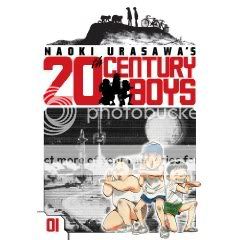
Naoki Urasawa’s 20th Century Boys Vols. 1-3
Naoki Urasawa, writer/artist
Viz, 2009
216 pages, Vols. 1&2
200 pages, Vol. 3
$12.99 each
I don’t like to read manga series until I have the whole thing. It’s not like superhero serials that are ongoing in perpetuity, or TV shows where the same thing is theoretically the case–these stories are serialized but they’re of a finite length, and I find that if I try to read a little here, a little there, I end up forgetting half of what’s going on by the time I catch up with later volumes. This isn’t really the fault of the material, mind you, it’s just because I’m not terribly bright.
Anyway, sometimes needs must, and so I found myself reading the three volumes of 20th Century Boys I have in my possession at the moment. (Without having Vols. 4-6, or god help me, without having finished Monster, since I’m missing about six volumes in the middle of the run and totally can’t remember what happened in the three or four volumes I already read. Like I said, not the sharpest knife in the drawer.) And this probably comes as a surprise to no one, but they’re a lot of fun. The story’s like a cross between Stephen King’s It and the Aum Shinrikyo Tokyo subway attack, with thirtysomething go-nowhere convenience-store franchisee Kenji discovering that the heroes-and-villains game he helped concoct as a kid is being used as a how-to manual for murdering people by a shadowy cult, most likely led by one of his childhood friends. The drill so far is one of watching bodies pile up and the revelations slowly accumulate, often in sublimely unexpected ways. There’s at least one supporting character who gets offed way before I’d have seen it coming, a lot of the secrets are way more out in the open than I’d have expected them to be at this stage in the game (a lot of “so, now you know that I know what you know”), there’s a wooly subplot involving a psychic bum, there’s a very cool t-shirt-ready symbol for the death cult…a thrill a minute, baby, and dammit, I wish I had the other three volumes.
That said, I think what prevents the Urasawa I’ve read from springboarding off its obvious proficiency with genre into the realm of genuinely great art is that his actual art, his drawings, are strictly functional. Actually, that’s not quite the word for it. “Strictly functional” implies “merely adequate,” and it’s more than that. The visual storytelling is crystal-clear, which is a huge help for a mystery translated from a foreign language with its own cultural cues. The character designs are easy to keep track of even as childhood friends are reintroduced at a dizzying pace. The line is as slick as manga gets, retaining energy during quieter scenes like a coiled spring that boings back up during confrontations and action sequences. But it only has style in the sense that, say, your basic Hollywood thriller has: The goal of the art is to stay out of the way of the story. I’m reminded of Pia Guerra’s work on Y: The Last Man–Urasawa would never draw anything that stiff, of course, but that kind of nondescript conveyor-of-information-type art is the sort of thing that works really well for a comic with this kind of broad civilian appeal. Are you here for an art class, or are you here to find out if Kenji can save the world?
Tags: comics, comics reviews, Comics Time, reviews

“That said, I think what prevents the Urasawa I’ve read from springboarding off its obvious proficiency with genre into the realm of genuinely great art is that his actual art, his drawings, are strictly functional. ”
I’ll agree in terms of being genuinely great art qua comics. Urasawa has not ever really done anything with the medium other than be really good at telling stories with it.
On the other hand, I do think he makes genuinely great art on a literary level because he deals with significant themes in substantive ways. The way he tells his stories may not be innovative or artistically brilliant (even if he is exceptionally adept at it) but the stories he tells, I think, have the sort of content that justifies calling them genuinely great art.
Especially 20th Century Boys, though it has barely had a chance to unfold itself yet to the degree necessary to see it.
So great storytelling (plotting, clarity, subtext, etc.) is not a component/example of great art? Disagree.
I think he meant “art” as a synonym for “visual art”, i.e., the illustrations, not “art” as “complete work of art”.
That said, I disagree with his assessment, and say that just by themselves, the crystal-clear storytelling and consistent, identifiable character design raise the cartooning above the level of 3/4 of the comics I read. Also, I love his backgrounds, even if (I guess) they’re probably being photoreferenced by assistants.
Krill: To me it’s just a fun potboiler, so far at least. I’m not seeing a sophisticated exploration of major themes.
Heidi: It’s a component (or it can be) but it’s not an example.
Scratchie: I actually did mean capital-A Art.
Well, shut my mouth.
Comics Time: Naoki Urasawa’s Monster Vols. 1-3
Naoki Urasawa’s Monster Vols. 1-3 Naoki Urasawa, writer/artist Viz, 2006 208-224 pages each $9.99 each Buy it from Amazon.com [First, a programming note. Because I read so many comics and write so many reviews, I end up reading and…